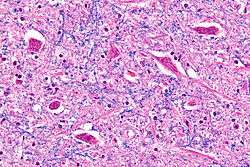Lower motor neuron
Lower motor neurons (LMNs) are motor neurons located in either the anterior grey column, anterior nerve roots (spinal lower motor neurons) or the cranial nerve nuclei of the brainstem and cranial nerves with motor function (cranial nerve lower motor neurons). All voluntary movement relies on spinal lower motor neurons, which innervate skeletal muscle fibers and act as a link between upper motor neurons and muscles. Cranial nerve lower motor neurons control movements of the eyes and tongue, and contribute to chewing, swallowing and vocalization. Damage to the lower motor neuron can lead to flaccid paralysis.
Classification
Lower motor neurons are classified based on the type of muscle fiber they innervate:

Motor neuron
A motor neuron (or motoneuron) is a nerve cell (neuron) whose cell body is located in the spinal cord and whose fiber (axon) projects outside the spinal cord to directly or indirectly control effector organs, mainly muscles and glands. Motor neurons' axons are efferent nerve fibers that carry signals from the spinal cord to the effectors to produce effects. Types of motor neurons are alpha motor neurons, beta motor neurons, and gamma motor neurons.
There are upper motor neurons and lower motor neurons, with the cell type described above being a lower motor neuron. Upper motor neurons are cortico-spinal interneurons that arise from the motor cortex and descend to the spinal cord where they activate the lower motor neurons through synapses. The term 'motor neuron' is usually restricted to the efferent neurons that actually innervate muscles (the lower motor neurons).
A single motor neuron may innervate many muscle fibres and a muscle fibre can undergo many action potentials in the time taken for a single muscle twitch. As a result, if an action potential arrives before a twitch has completed, the twitches can superimpose on one another, either through summation or a tetanic contraction. In summation, the muscle is stimulated repetitively such that additional action potentials coming from the somatic nervous system arrive before the end of the twitch. The twitches thus superimpose on one another, leading to a force greater than that of a single twitch. A tetanic contraction is caused by constant, very high frequency stimulation - the action potentials come at such a rapid rate that individual twitches are indistinguishable, and tension rises smoothly eventually reaching a plateau.

Alpha motor neuron
Alpha (α) motor neurons (also called alpha motoneurons), are large, multipolar lower motor neurons of the brainstem and spinal cord. They innervate extrafusal muscle fibers of skeletal muscle and are directly responsible for initiating their contraction. Alpha motor neurons are distinct from gamma motor neurons, which innervate intrafusal muscle fibers of muscle spindles.
While their cell bodies are found in the central nervous system (CNS), α motor neurons are also considered part of the somatic nervous system—a branch of the peripheral nervous system (PNS)—because their axons extend into the periphery to innervate skeletal muscles.
An alpha motor neuron and the muscle fibers it innervates is a motor unit. A motor neuron pool contains the cell bodies of all the alpha motor neurons involved in contracting a single muscle.
Location
Alpha motor neurons (α-MNs) innervating the head and neck are found in the brainstem; the remaining α-MNs innervate the rest of the body and are found in the spinal cord. There are more α-MNs in the spinal cord than in the brainstem, as the number of α-MNs is directly proportional to the amount of fine motor control in that muscle. For example, the muscles of a single finger have more α-MNs per fiber, and more α-MNs in total, than the muscles of the quadriceps, which allows for finer control of the force a finger applies.
Beta motor neuron
Beta motor neurons (β motor neurons), also called beta motoneurons, are a kind of lower motor neuron, along with alpha motor neurons and gamma motor neurons. Beta motor neurons innervate intrafusal fibers of muscle spindles with collaterals to extrafusal fibers (type of slow twitch fibers). Axons of beta motor neurons (as alpha and gamma motor neurons) are myelinated. Alpha, gamma and beta motor neurons are all efferent neurons that originate from the anterior grey column of the spinal cord and travel to skeletal muscles. Alpha motor fibers have a larger diameter and higher conduction velocity than beta and gamma motor fibers.
Types of beta motor neuron
There are two kinds of beta motor neuron (as gamma motor neuron) that include:
Podcasts:
Latest News for: lower motor neuron
Former Lioness captain Steph Houghton shares heartbreaking update on her husband: 'I can't pretend that ...
The Daily Mail 21 Mar 2025- 1

